How IoT Is Revolutionizing Agriculture: Smart Farming Explained
The agricultural industry is changing fast, thanks to IoT in Agriculture in farming. Smart farming uses advanced tools like sensors, drones, and data analytics. It’s changing how we grow and manage crops.
This new tech lets farmers make better choices based on data. It helps them grow more crops and waste less. By using smart farming, you can use resources better, stop diseases before they start, and make your farm more productive.
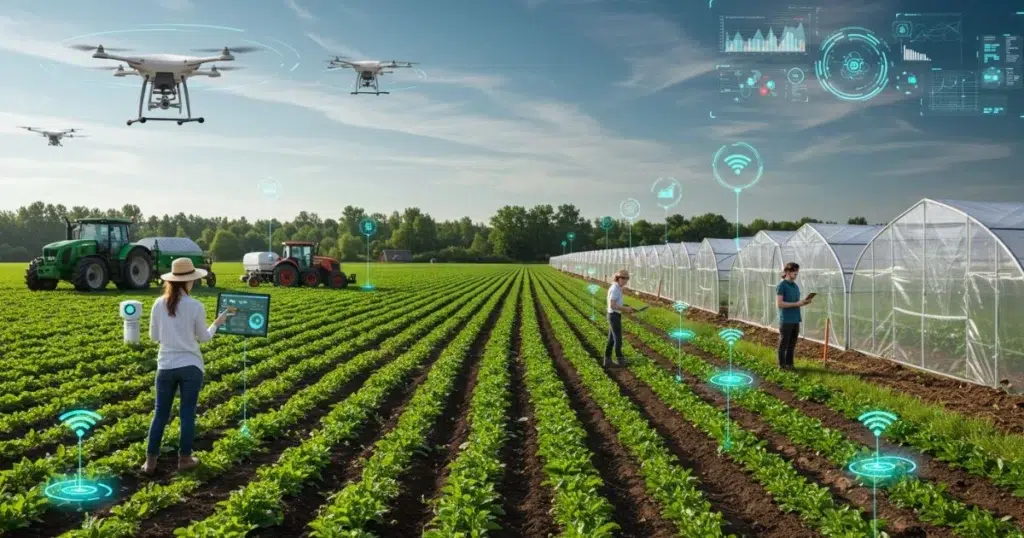
Key Takeaways
- Smart farming integrates IoT technologies to enhance agricultural productivity.
- Data analytics and sensors play a critical role in smart farming.
- Farmers can make informed decisions using real-time data.
- Smart farming helps in optimizing resource allocation and reducing waste.
- Predictive analytics can help prevent crop diseases.
The Current State of Agriculture and Its Challenges
The agricultural industry is facing big challenges. These include growing global food demands and climate change impacts. With the world’s population increasing, farming must produce more with less. This calls for new solutions to make farming more productive, efficient, and sustainable.
Traditional Farming Limitations and Inefficiencies
Traditional farming has its limits. It often relies on manual labor, which is slow and error-prone. These methods also don’t consider the unique conditions of each farm, like soil and weather. This can cause waste and harm the environment.
Agriculture sensors and sensors for farming can help a lot. They give real-time data on soil moisture, temperature, and crop health. This lets farmers make better choices and improve their farming.
Why Modern Farms Need Technological Innovation
Modern farms need new technology to tackle their challenges. IoT technologies, like sensors and data analytics, can change farming. For example, precision irrigation systems save water by giving crops just what they need.
Technology also helps farmers deal with climate change. Weather monitoring sensors help farmers prepare for extreme weather. This reduces the chance of crop failure.
In summary, agriculture today faces big challenges. But, technology can help solve these problems. Using sensors for farming and IoT solutions is key to making farming more efficient, productive, and sustainable.
Understanding IoT in Agriculture: Core Concepts and Benefits
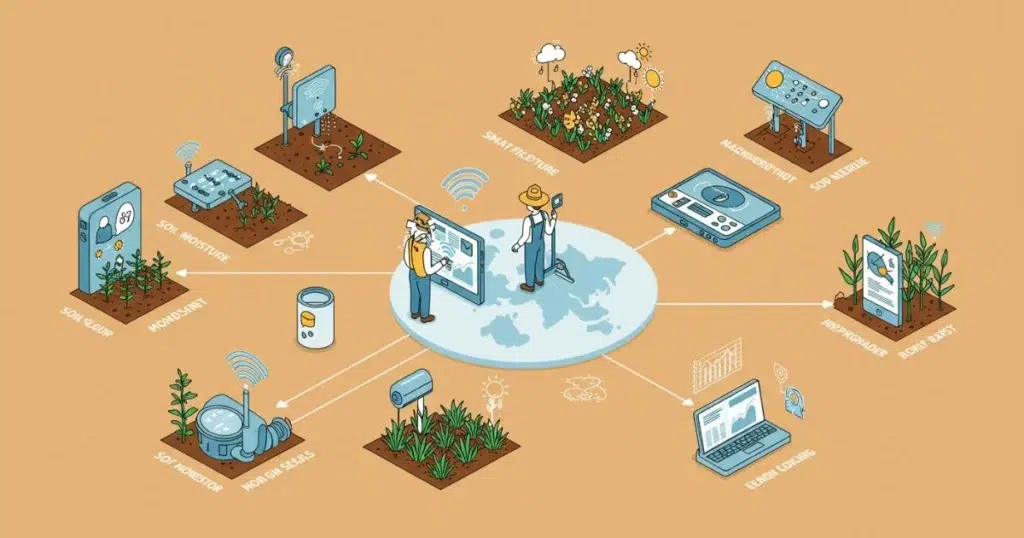
IoT technology is changing how we farm. It lets farmers make better decisions with data. This makes farming more efficient and productive.
IoT, or the Internet of Things, connects devices and items. They have sensors and software. This lets them share data. In farming, it creates a smart farming ecosystem to monitor and improve farming processes.
What Is IoT and How It Transforms Farming Operations
IoT in farming uses devices and sensors. They track soil moisture, temperature, and crop health. This data helps farmers decide on irrigation, fertilization, pest control, and harvesting.
IoT technology automates tasks, cuts waste, and boosts crop yields. For example, IoT irrigation systems adjust water based on soil moisture. This ensures crops get the right water at the right time.
The Components of a Smart Farming Ecosystem
A smart farming ecosystem has several parts:
- Sensors and Devices: They collect data on soil moisture, temperature, and crop health.
- Data Management Systems: These systems store and analyze data from sensors. They provide insights.
- Connectivity Solutions: These allow devices and systems to communicate. They ensure data exchange.
- Automation and Control Systems: These systems use data insights to automate tasks. This includes irrigation and fertilization.
By understanding and using these components, you can build a smart farming ecosystem. It improves your farming and supports sustainable agriculture.
Essential Agriculture Sensors for Smart Farming
Farmers are now using essential agriculture sensors to boost crop yields and cut down on waste. These sensors are key parts of an agricultural sensor station. They give farmers important data to make smart choices.
Soil Moisture and Nutrient Sensors
Soil moisture sensors check the water in the soil, helping farmers plan better irrigation. Nutrient sensors, in turn, track the soil’s nutrient levels. This ensures crops get the nutrients they need to grow well.
Using these sensors helps farmers cut down on water waste and keep crops healthy. For example, a study showed that soil moisture sensors can greatly lower water use.
Weather and Environmental Monitoring Sensors
Weather and environmental sensors give vital info on temperature, humidity, wind speed, and more. This data helps farmers get ready for weather changes and protect their crops from damage.
- Temperature sensors check soil and air temperatures.
- Humidity sensors measure air moisture levels.
- Weather stations offer detailed weather data.
Crop Health and Growth Sensors
Crop health and growth sensors watch over crop conditions and growth. They spot problems like diseases, pests, and nutrient shortages. This lets farmers act fast.
Some common crop health sensors include:
- Multispectral and hyperspectral cameras that check crop health.
- NDVI (Normalized Difference Vegetation Index) sensors that measure crop strength.
Livestock Monitoring Sensors
Livestock monitoring sensors track animal health, behavior, and location. These sensors help farmers improve animal care and manage livestock better.
Examples of livestock monitoring sensors include:
- Wearable sensors that track animal health and behavior.
- GPS tracking systems that monitor animal location.
How to Set Up Your Agricultural Sensor Station
To get the most out of precision agriculture, setting up your sensor station is key. It involves several important steps. These steps make sure your farm can collect and use data well.
Selecting the Right Sensors for Your Farm’s Needs
The first thing to do is pick the right agriculture sensors for your farm. Sensors like those for soil moisture, weather, or crop health are important.
Think about your crops, farm size, and challenges when choosing sensors. For example, soil moisture sensors are great for farms facing water issues.
- Soil Moisture and Nutrient Sensors: These help with better irrigation and fertilization.
- Weather and Environmental Monitoring Sensors: They give you real-time weather data for better decisions.
- Crop Health and Growth Sensors: These track your crops’ health and growth, helping you act fast if problems come up.
Installation and Placement Best Practices
After picking the right sensors for farming, install them correctly. The right installation and placement are key for accurate data.
Here are some tips:
- Put soil moisture sensors at various depths for a full view of soil moisture.
- Install weather stations in open areas, away from blocks.
- Place crop health sensors among the crops for accurate data.
Connecting Your Ag Sensors to Data Management Systems
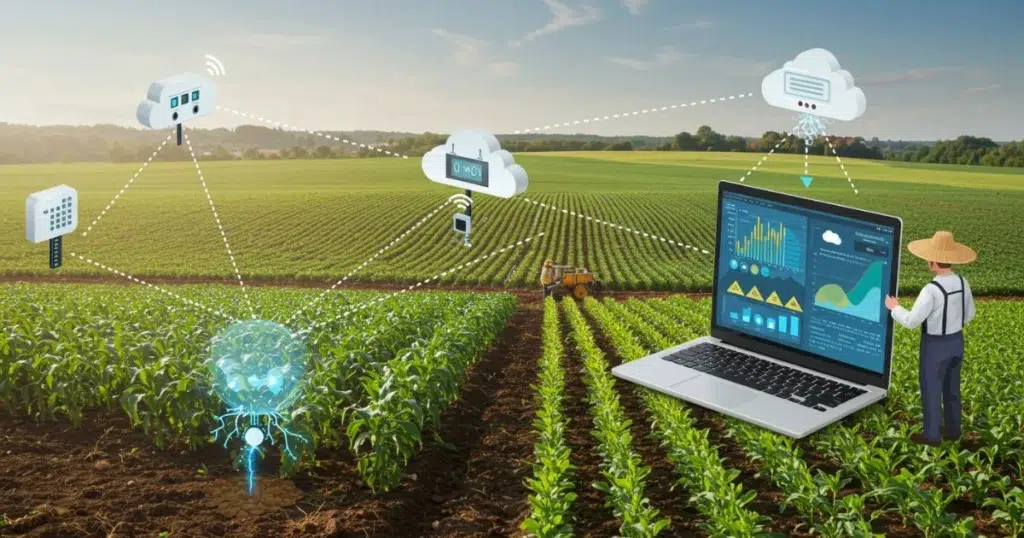
After installing your agriculture sensors, connect them to a data system. This system will handle and analyze your data, helping you make smart choices.
Choose a data system that’s easy to use, grows with you, and works with your sensors. Many systems are cloud-based, making them flexible and accessible.
By following these steps and tips, you can set up a top-notch agricultural sensor station. This will boost your farm’s productivity and efficiency.
Implementing Precision Agriculture with IoT Solutions
IoT solutions help you implement precision agriculture, making farming better. Precision agriculture uses advanced tech to improve farming. This leads to better crops, less waste, and more efficient use of resources.
IoT technologies like sensors, drones, and data analytics are key. They help you understand your farm better and make smart decisions.
Developing Smart Irrigation Systems
IoT is great for creating smart irrigation systems. These systems use sensors and weather data to water crops perfectly. This ensures your crops get the right water at the right time.
Smart irrigation systems help you:
- Save water and reduce waste.
- Keep crops healthy by avoiding too much or too little water.
- Lower energy costs by using pumps more efficiently.
Experts say precision irrigation is vital in precision agriculture. It helps farmers use water wisely. This is good for your farm and the environment.
Creating Precision Fertilization Programs
IoT also improves fertilization. Soil nutrient sensors and data analytics help create fertilization plans for your crops.
This involves:
- Testing soil to see nutrient levels.
- Using data to figure out the best fertilizer amounts.
- Applying fertilizer in the right spots for better results.
With precision fertilization, you can improve soil health, cut down on waste, and grow healthier crops.
Establishing Targeted Pest Management Protocols
IoT also helps with targeted pest management. This reduces chemical use and keeps ecosystems healthy.
With sensors and monitoring, you can:
- Spot pests early and act fast.
- Know exactly which pests you’re dealing with.
- Use precise pesticide application to protect the environment.
As farming evolves, IoT will be key in precision agriculture. Using these technologies helps you stay ahead and succeed in farming.
Optimizing Livestock Operations Through IoT Monitoring
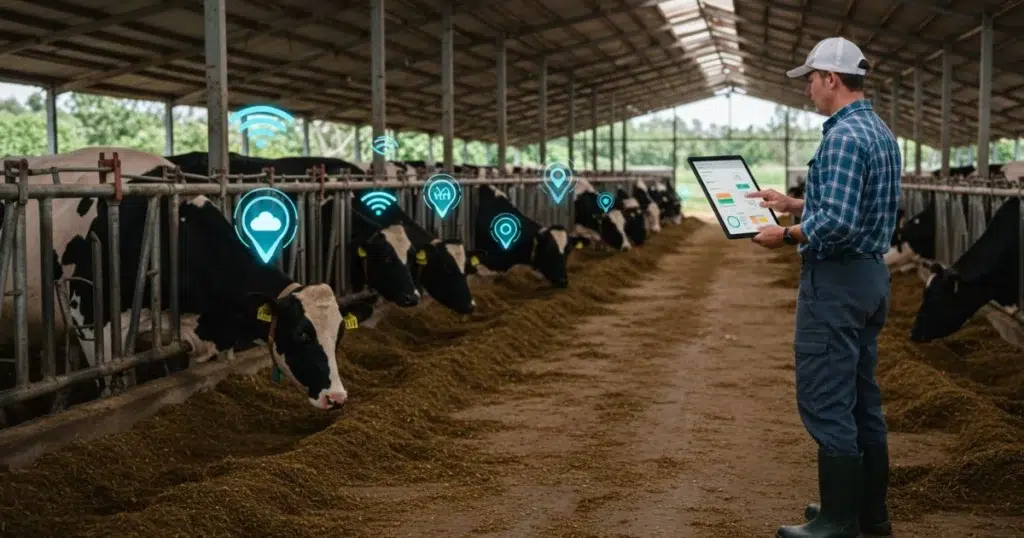
IoT monitoring helps farmers make better decisions for their livestock. By using livestock monitoring sensors and ag sensors, they can automate many tasks. This includes tracking health, feeding, and care.
IoT technology lets farmers monitor and collect data in real-time. They can then analyze this data to spot trends and patterns. This helps them make informed choices, reducing the need for manual checks.
Setting Up Automated Health Tracking Systems
Automated health tracking systems use livestock monitoring sensors to watch vital signs. They can catch early signs of illness or stress. This lets farmers act quickly.
To set up an automated health tracking system, you need to:
- Choose the right sensors for your livestock, considering factors like the type of animal, size, and specific health indicators to be monitored.
- Install the sensors in a way that ensures accurate data collection without causing discomfort to the animals.
- Integrate the sensor data with your farm management software to analyze and act on the information.
Implementing Efficient Feeding and Care Solutions
Efficient feeding and care are key for healthy and productive livestock. IoT technology, through ag sensors, can optimize feeding by tracking consumption and growth.
By using IoT for feeding, you can:
- Monitor feed consumption in real-time, adjusting feeding schedules as needed.
- Use data analytics to optimize feed formulations, ensuring that nutritional needs are met.
- Reduce waste and improve the overall efficiency of your feeding operations.
By using IoT monitoring and livestock monitoring sensors, you can greatly improve your livestock operations. This boosts animal welfare and makes your farm more sustainable and profitable.
Leveraging Data for Smarter Farming Decisions
The data from your farm’s IoT devices is key to smarter farming. It helps in optimizing crop growth and resource use. Understanding and using this data is vital.
Interpreting and Acting on Sensor Data
To use your data well, connect your agriculture sensors to data management systems. These systems organize, analyze, and show your data. This makes spotting trends and patterns easier.
Key steps for using sensor data include:
- Monitoring soil moisture for better irrigation
- Using weather data to prepare for extreme weather
- Tracking crop health to find areas for improvement
Using Predictive Analytics for Crop Management
Predictive analytics is a strong tool for farm decisions. It uses past data and current sensor readings to forecast issues. This lets you act early to avoid problems.
Ways to apply predictive analytics include:
- Forecasting crop yields based on past and current data
- Spotting pests and diseases before they spread
- Optimizing fertilizer and pesticide use to reduce waste
Developing Long-term Farm Strategies with IoT Insights
IoT insights and data management systems help in planning for the future. Analyzing data trends helps spot areas for improvement. This guides decisions on future investments.
Key points for long-term planning include:
- Checking the ROI of IoT solutions and agriculture sensors
- Assessing new tech’s impact on farm operations and profits
- Finding chances to grow or diversify your farm
Overcoming Challenges When Adopting IoT in Agriculture
When you think about using IoT in farming, you’ll face some hurdles. IoT can make farming more efficient and productive. But, there are challenges to get past.
One big challenge is connectivity issues in rural areas. Many farms are far from cities and have poor internet. This makes it hard to connect IoT devices.
Addressing Connectivity Issues
To solve this, look into other ways to connect, like satellite internet or special cell networks. Pick the best option for your farm’s needs.
Another hurdle is managing costs and calculating ROI. IoT can cost a lot, so you need a good plan and budget.
Managing Costs and ROI
To keep costs down, do this:
- Do a detailed cost-benefit analysis to see if it’s worth it.
- Focus on IoT solutions that will really help your farm.
- Choose solutions that can grow or change as needed.
Training farm staff on new tech is key for a smooth transition to IoT farming.
Training Farm Staff
To train your team well, do this:
- Offer in-depth training on using and fixing IoT devices.
- Make sure staff know the good and bad of IoT.
- Ask for feedback and keep learning to get the most from IoT.
By tackling these challenges, you can make IoT work for your farm. This way, you can enjoy the benefits of smart farming.
Conclusion: The Future of Agriculture with IoT
The use of IoT in farming is changing how we grow food. It makes farming more efficient, productive, and green. By using agriculture sensors and IoT, you can grow more crops, waste less, and farm smarter.
The future of farming is bright with these new technologies. They help tackle big challenges in the industry. With the right tools and knowledge, you can farm more precisely, take care of livestock better, and make smart choices for your farm.
As farming keeps changing, it’s key to keep up with new IoT solutions. This way, you’ll boost your farm’s output and help make food production more sustainable. The possibilities with smart farming are endless, and you’re ready to use IoT to improve your farm.
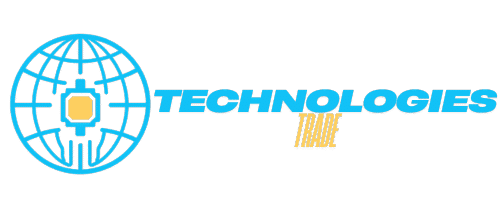
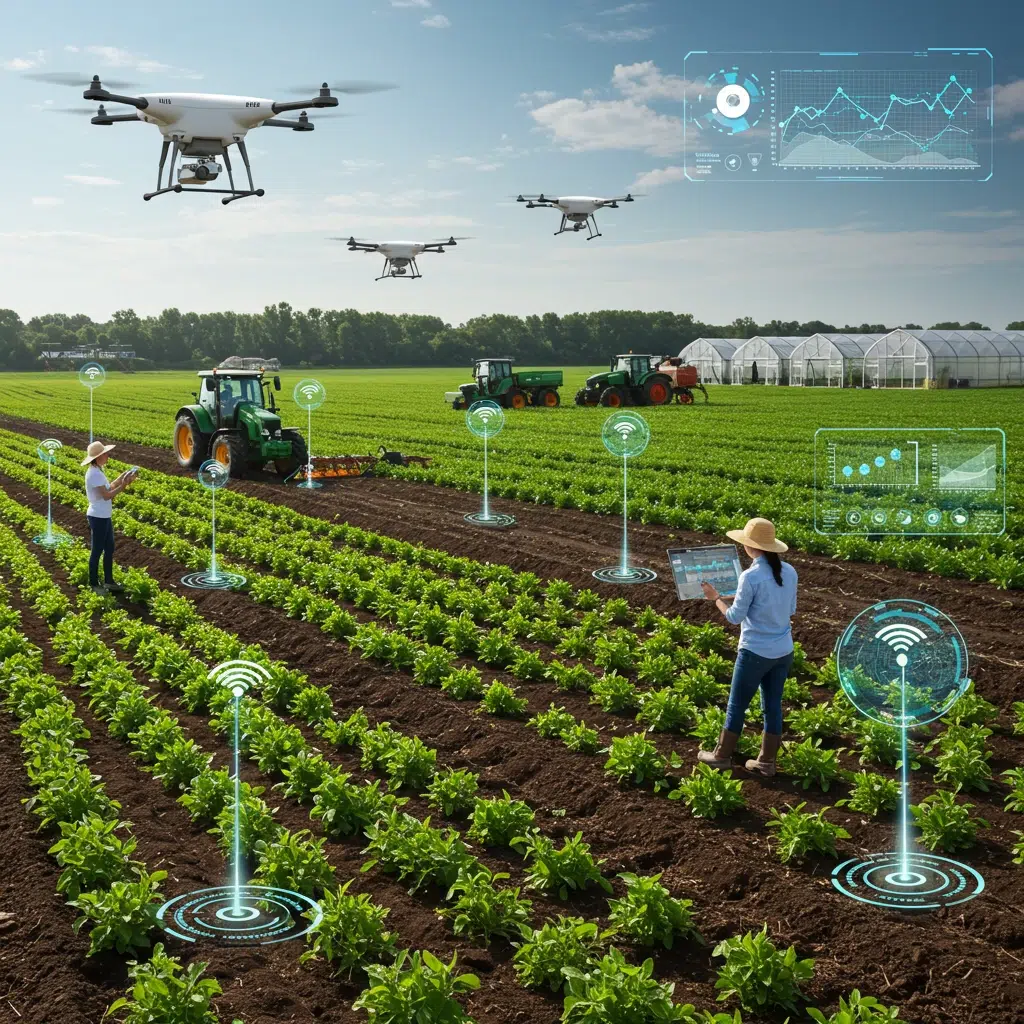
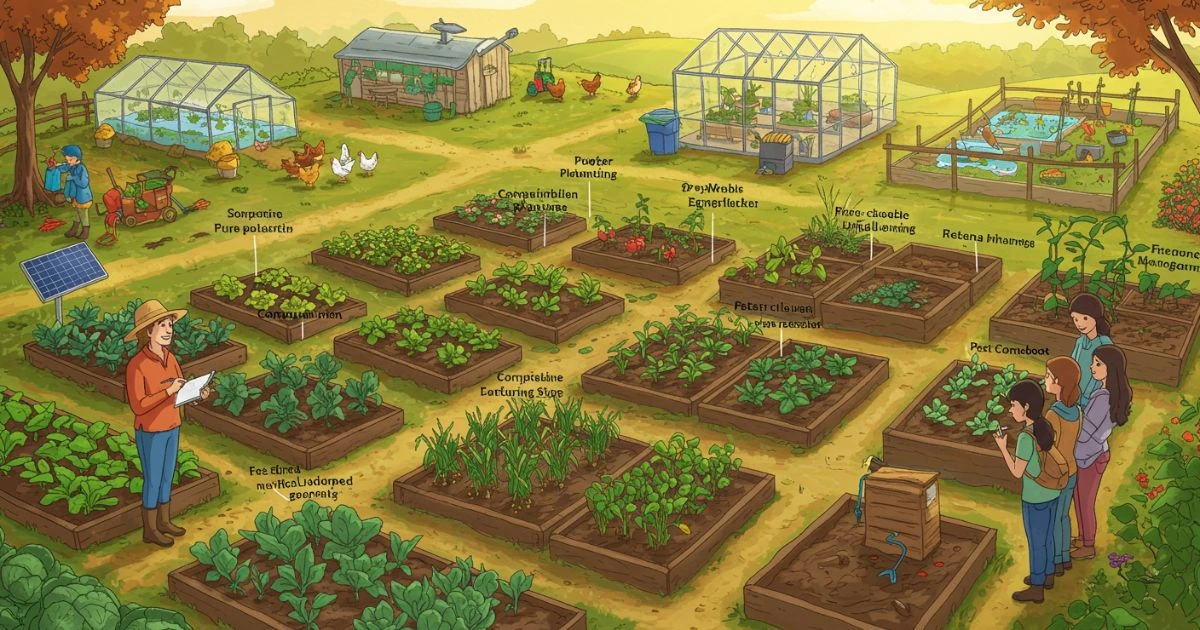
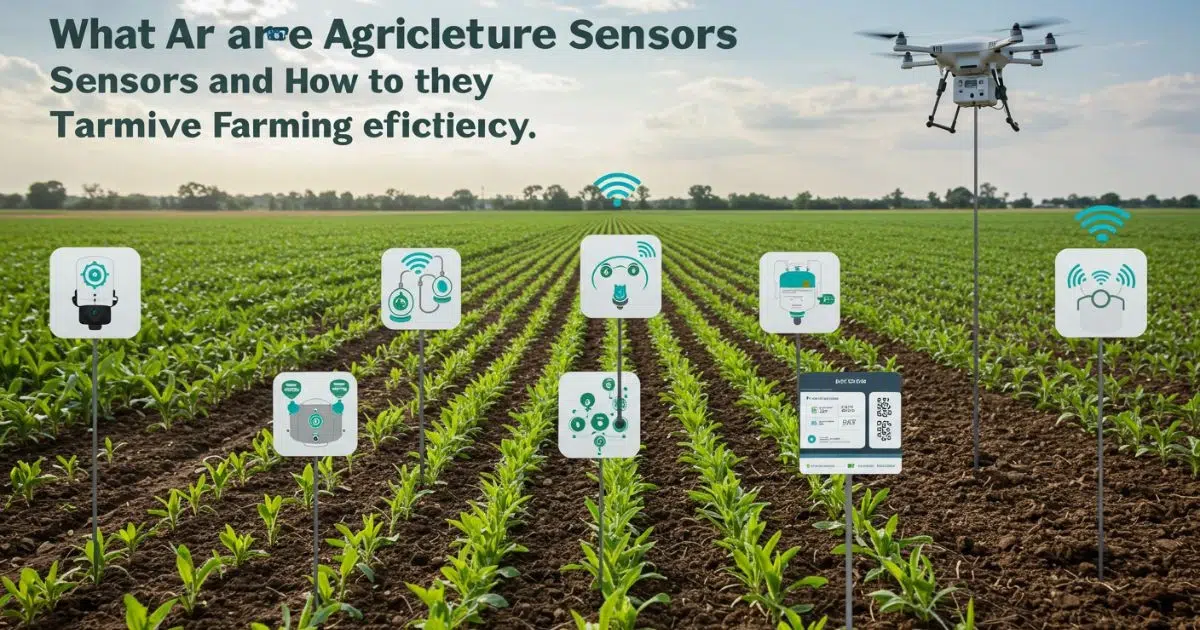
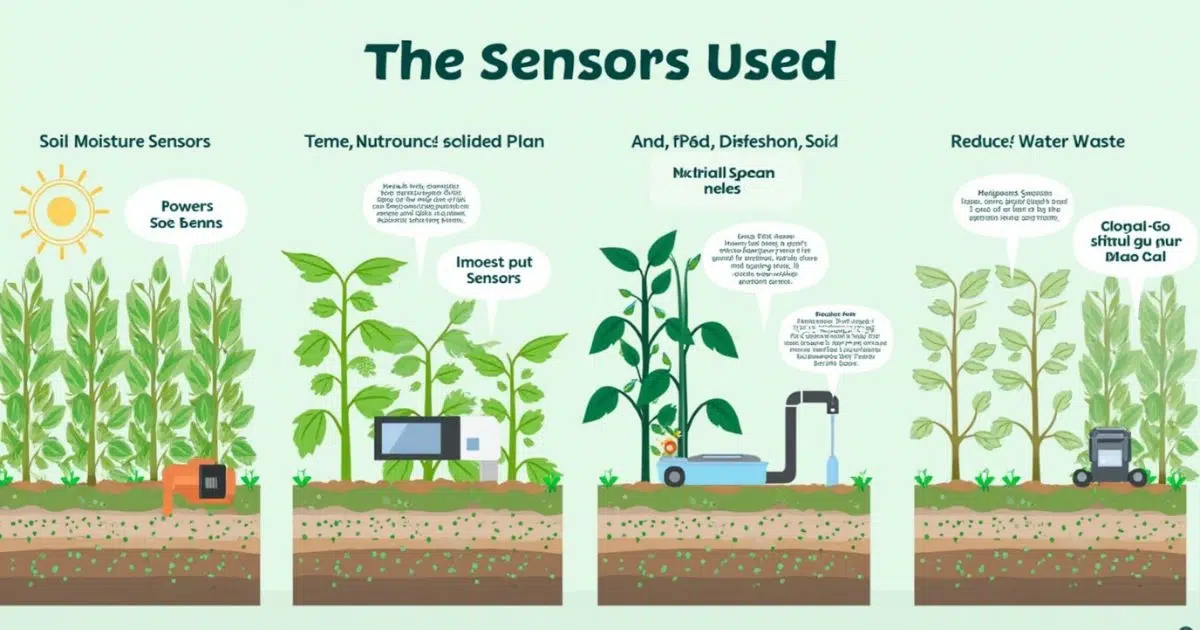
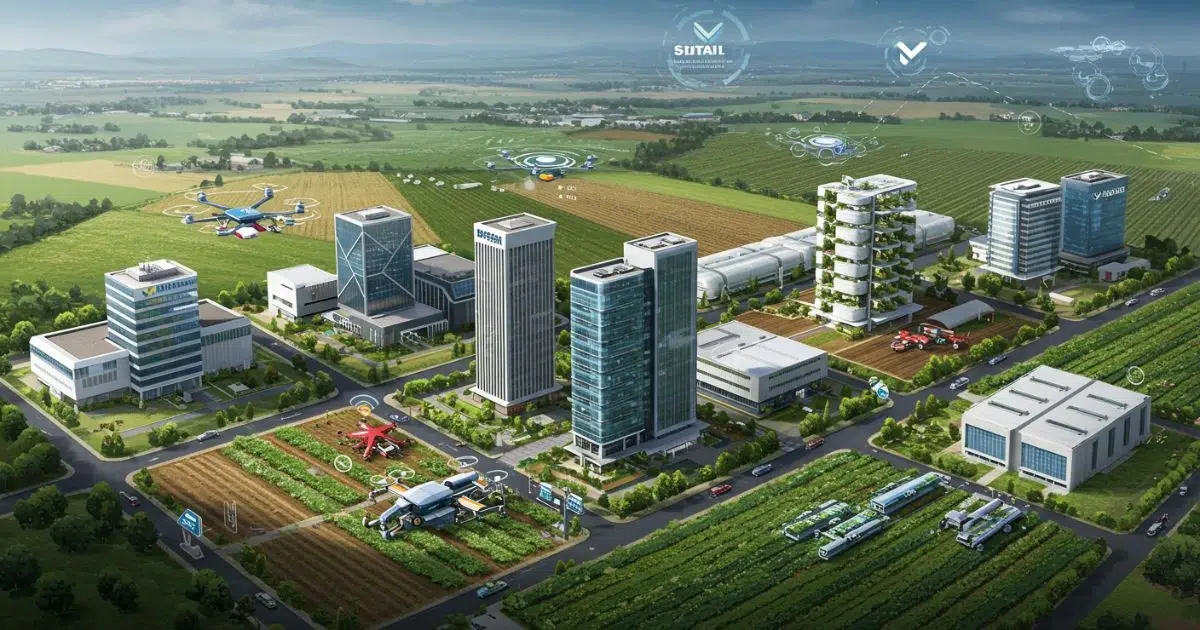
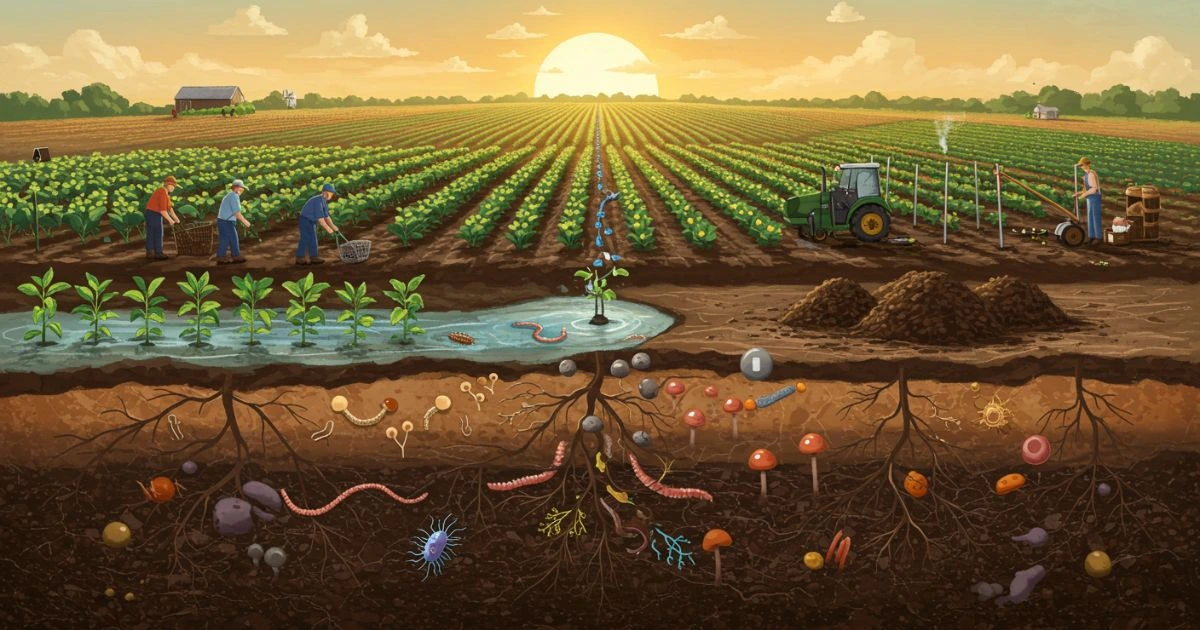
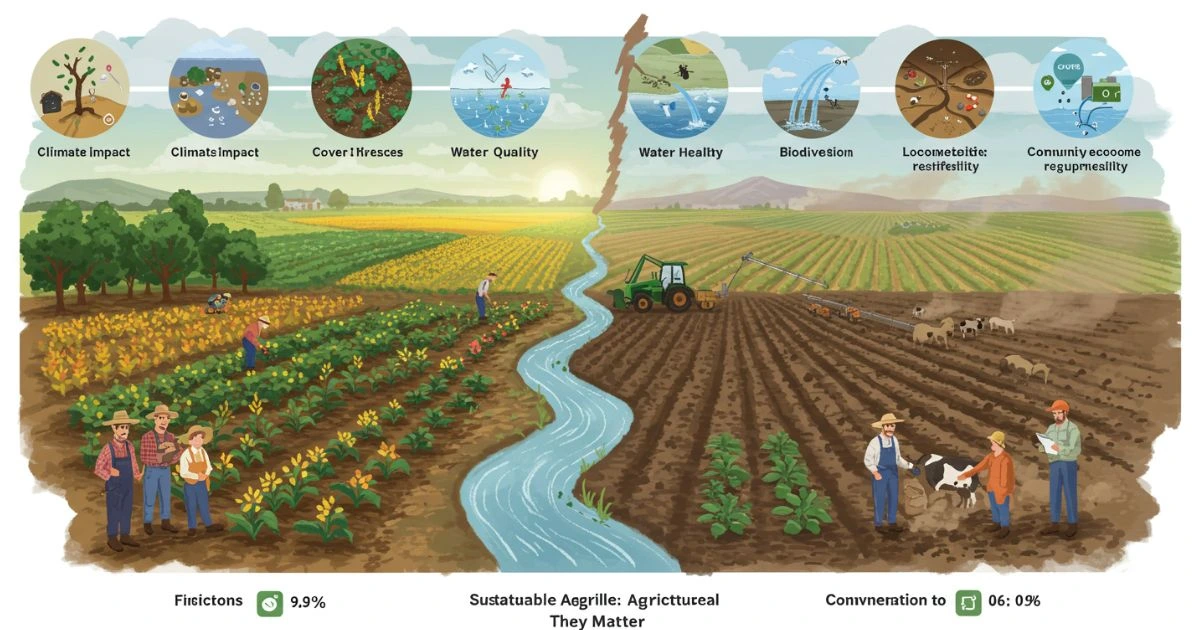
Leave a Reply